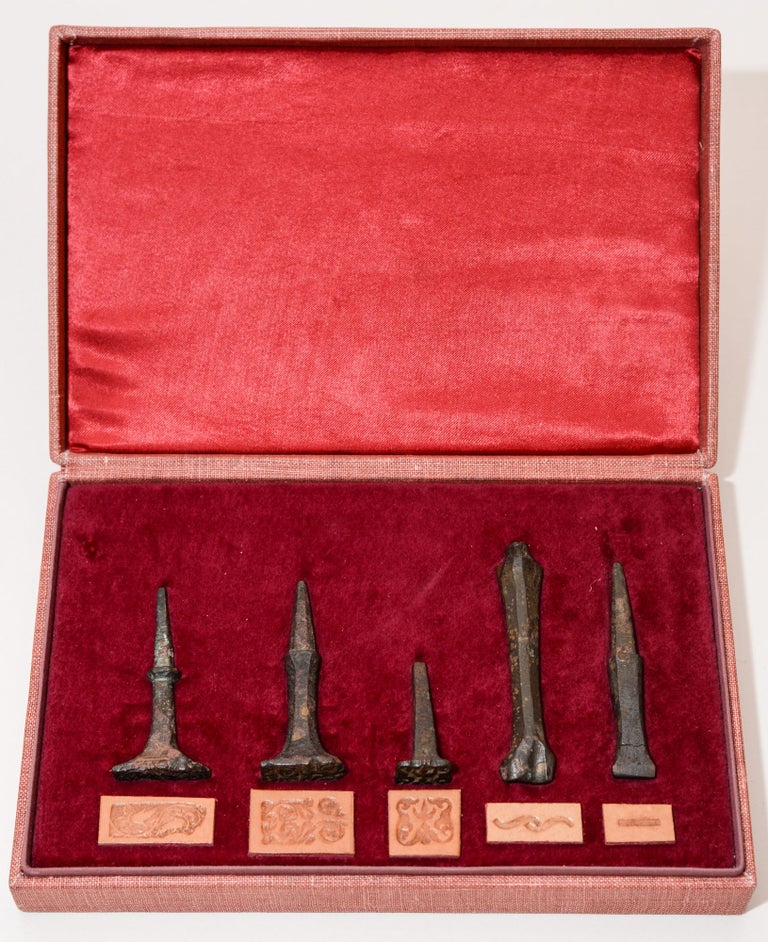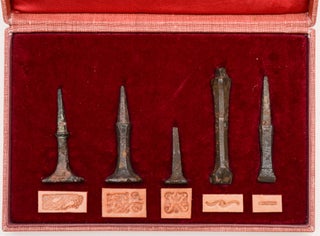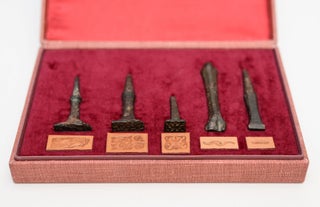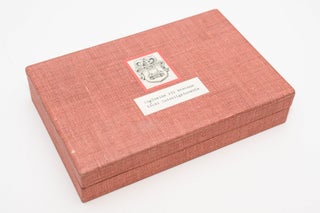A Collection of Five 16th Century Polish Binding Tools
Krakow: 16th century. Five iron tools with different stamps. Housed in mid-century, custom made casket, covered in red cloth. Title vignette and imaginary bookbinder’s coat of arms mounted on the lid. Covered internally with red plush and silk, the bottom is designed with concave shapes for the tools. Sample on leather of each pattern mounted beneath the matching tool. The tools with traces of rust and abrasions by usage and aging. Wooden handles are not presented. The stamps are sharp, clearly identifiable. Overall in fine condition.
Five original, sixteenth-century finishing tools, probably from the workshop of the Cherub’s Head Binder in Cracow.
Late Gothic, early Renaissance finishing tools, for border patterns. Two panels with elaborate floral motifs (no. 1; 2 from left to right), one with an arabesque (no. 3), and two simpler pallets to impress waves (no. 4) and lines (no. 5) or create complex knotwork decorations.
The arabesque (no. 3), is a version of an Italian stamp for border-frieze used widespread in the late 15th century, among others by the Venetian Tiepolo Master (see De Marnis 1960; I, n. 473, tav. LXXXVIII). The same design was used by Maciej from Przasnysz, the so-called Cherub’s Head Binder in Krakow. One of his bindings, tooled with this arabesque is reproduced in Anthony Hobson’s study, the Humanists and bookbinders (Hobson, 1989; Fig. 102, p. 129), and referred to it in other sources as well. It is also presented in the monograph about the library of the Mikołaj Czepiel (1453–1518, Polish Humanist scholar, diplomat, and professor at the Jagiellonian University of Kraków), together with the narrow floral stamp (no. 1) as finishing patterns applied by a Cracow-binder, however not associated with Cherub’s Head Binder (Lewicka-Kamińska 1956; Tabl 17, nr. 19; Tabl. 18, nr. 39).
Italian influence on bookbinding of the fifteenth and sixteenth century is particularly noticeable in Cracow, then the capital of Poland. The Italianate grammar of ornament had in part been transmitted through Hungary and Bohemia, and partly by the Polish students, diplomats, travelers and Catholic dignitaries who brought home the manuscripts and books they purchased in Italy. The first covers imitating Italian bindings were created in Cracow in the second half of the fifteenth century, and they became prevalent by the first decade of the sixteenth century. The most outstanding bookbinder of such style in Cracow was Maciej from Przasnysz, the Cherub’s Head Binder, who was active around 1620–1640. Apart from alla greca bindings he used the patterns of Aldine book bindings and mixed architectonic compositions with the Italian ornamental motives. His binding could be found in the libraries of the wealthiest Polish bibliophiles and humanists, among them the collections of the bishop Piotr Tomicki, and Piotr Wedeliczki, Professor of Medicine in the University of Cracow and his brother Jakub, Canon of Poznań.
Bibl.: De Marnis, T.: La legatura artistica in Italia nei secoli XV e XVI. Notizie ed elenchi, Firenze: Fratelli Alinari, 1960.; Hobson, A.: Humanists and bookbinders. The Origins and Diffusion of the Humanistic Bookbinding 1459–1559 […]. Cambridge: Cambridge University Press, 1989.; Lewicka-Kamińska, A.: Renesansowy księgozbiór Mikołaja Czepla w Bibliotece Jagiellońskiej. Wrocław: Zakład im. Ossolińskich, 1956. Wagner, A.: The Lecture: Italian Influence on Polish Bookbinding During the 15th and the 16tth Century. Retrieved January 30, 2019, from http://www.rzym.pan.pl/index.php/en/chronicle/56-chronicle-2014/269-lecture-february-11th
.
Price: €60,000.00




